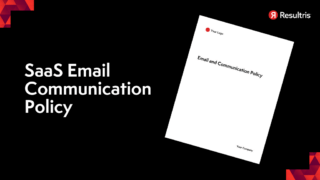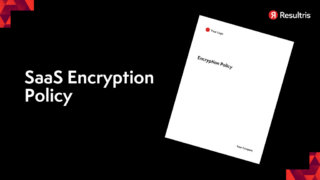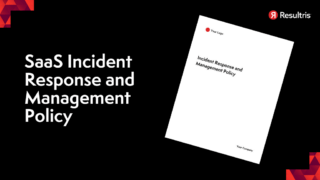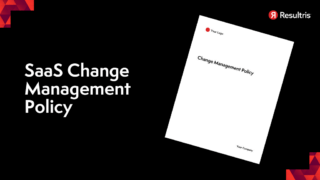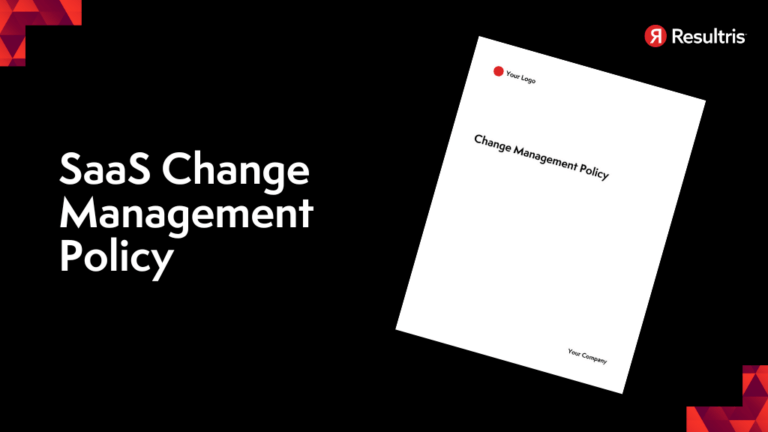
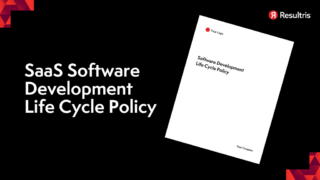
Written by: Tim Eisenhauer
Last updated:

In the dynamic world of Software as a Service (SaaS), a robust change management policy isn’t just a nice-to-have—it’s a must. But what does it really mean to implement such a policy, and how can it drive your business forward?
Whether you’re a seasoned SaaS pro or a newcomer to the scene, understanding the ins and outs of change management can be daunting. But don’t worry, you’re about to embark on a journey that’ll demystify this crucial aspect of SaaS operations.
In this article, we’ll delve into the essence of a SaaS change management policy, and why it’s integral to maintaining SaaS Compliance and Security Best Practices. We’ll also explore how it can help your organization stay agile, secure, and ahead of the curve. So buckle up, because change—managed right—can be a powerful tool.
Grasping the concept of SaaS change management policies doesn’t have to be daunting. Let’s delve into this topic.
A SaaS Change Management Policy ,as the term implies, is a strategic blueprint outlining how a SaaS company handles alterations in its services or operations. It guides when, why, and how these changes are made, with the caveat that they enhance the overall functionality, reliability, and user experience of a SaaS application.
In the realm of SaaS, rampant technological advancements necessitate constant adaptation and refinement. Here comes into play the SaaS change management policy. It ensures a streamlined modification process, minimizing the likelihood of any adverse impact on the service quality and customer satisfaction.
It’s all about creating a win-win situation. You strive for innovation yet don’t want your service routine to be affected anymore than your customers do. A SaaS change management policy assists in this balancing act, taking into account the necessary shifts while upholding service stability and reliability.
When it comes to client relationships, consistency is key. Unexpected changes can unsettle a user’s routine, inciting confusion or frustration. If your policy is sound, you can effectuate updates while minimizing customer disruptions.
Aside from ensuring seamless service operations, a robust SaaS change management policy also bolsters security and compliance. It delineates protocols for instituting modifications without compromising the safeguarding of sensitive data and compliance to regulations. It’s a compelling witness to how multiple challenges can be simultaneously addressed.
Your SaaS Change Management Policy isn’t just a simple document—it’s an essential blueprint that determines how your company adapts to future changes.
Changes in a SaaS environment typically fall into several categories.
Planned changes serve as an integration of alterations made consciously and strategically over time. For example, features added in response to user feedback. Unplanned changes, conversely, reactively address unexpected circumstances, like bug fixes or introducing new security measures in response to unforeseen threats.
Major changes often involve structural modifications. Consider an addition of a completely new service line in your SaaS offering—that’s a major change. Minor changes, on the contrary, make smaller adjustments, such as tweaking user interface elements or enhancing the efficiency of an existing feature.
Threats to data security and operational disruptions call for emergency changes. These are critical adjustments made swiftly to contain a security breach or restore disrupted services.
The procedure of requesting a change involves submitting a formal request, specifying the intrinsic nature of the change, its purpose, and potential impact. Essentially, driving the right communication starts here.
Every requested change goes through an evaluation process. It assesses potential pros, cons, risks, and compliance issues. Based on the evaluation, the change gets approved, delayed, or declined.
Following approval, it’s time for implementation. Here, you put your proposed modifications into practice, testing every implemented change to ensure it meets desired outcomes and doesn’t disrupt existing processes or infringe data protection norms.
Not all changes work as anticipated. That’s when rollback plans become your rescue route. They act as precautionary measures, allowing you to reverse any implemented change that poses unexpected issues or fails to deliver anticipated results. In other words, rollback plans are your safety net in the potentially unpredictable realm of SaaS modification.
Understanding stakeholders’ roles contributes to effective change management. Let’s unpack the responsibilities of several key players, namely, the executive leadership, Change Advisory Board (CAB), Development and Operations teams, and Customer Support.
At the helm are executive leaders, the strategic architects. They set the vision for change, emphasizing its necessity to the company’s growth and survival. Their decisions hold weight; hence, their support is crucial for change rollout. Moreover, they’re responsible for fostering a culture receptive to changes. Their role, though strategic, also requires them to liaise with other stakeholders and uphold transparency.
Next, we have the Change Advisory Board. Their role resembles a gatekeeper, critically reviewing, prioritizing, and either approving or declining proposed changes. Balancing technical feasibility with business outcomes, they ensure changes align with the company’s strategic direction and customer needs. They also orchestrate discussions, with input from several departments, making well-indicated decisions to further minimize potential risks.
The Development and Operations teams are the engine room for changes. They perform the bulk of technical tasks—coding, optimization, testing, and rolling out changes. These teams nurse a change from conception to fruition, instrumental in honoring compliance standards, performance benchmarks, and user experience metrics. Their responsibility, substantial, is hence paramount to a successful change management policy.
Lastly, Customer Support and Communication teams form the company’s connection to its customer base. As change liaisons, they keep users updated about impending changes, downtimes, enhancements, and even workarounds. Their role, B2C (business-to-consumer), is essential to ensure the changes cause minimal disruption to the user base. They alleviate customer concerns, gather feedback and insights into user sentiment- all those invaluable in shaping an effective change management policy.
Crafting an effective change management policy is no small feat—it takes insightful planning, diligence, and above all, a flexible approach. You’ll find a roadmap for policy creation below, designed to streamline this complex process.
Kickstart your journey by reviewing what’s currently in play. Pinpoint current procedures for implementing alterations. Identifying what works well, what doesn’t, it’s time to find what needs to stay and what requires a revamp. You’re not merely looking for problems—you’re also spotting opportunities.
Next up, lay out a categorization system. This structure helps keep track of variations, sorting them into manageable clusters like planned vs unplanned or major vs minor alterations. Further, prioritization enables strategic application of resources, ensuring that critical changes get the attention they deserve. Remember, not all modifications are created equal. Applying a rank-based model can improve workload management and risk control.
You’re rolling now. It’s onto the development of approval workflows— a standardized set of procedures guiding who signs off on what changes and when. A vital subpart— creating a Change Advisory Board, a unit that assesses alterations and offers expert recommendations. Executive leadership sets the change vision, while Development and Operations teams manage technical tasks. Keep this streamline, and you’ll experience fewer bottlenecks.
Lastly, introduce a tracking and documentation system. Why is it critical? It serves multiple purposes: it provides a historical account of alterations, eases audit compliance, meets regulatory conditions, and fine-tunes learning from past experiences. Proper documentation can also prove invaluable when informing stakeholders about current and future changes.
Following these steps helps establish a dynamic, effective, and comprehensive SaaS change management policy, ensuring a balance between innovation, compliance, and customer satisfaction. Keep going, lean into the process, let’s make change work for you.
Let’s dive into key practices that can significantly bolster your SaaS change management policy.
As part of your SaaS change management agenda, performing robust risk assessment and adopting appropriate mitigation strategies remain paramount. Risk assessment, in essence, involves identifying potential threats, assessing their impact, and determining the likelihood of their occurrence. For instance, a new feature could potentially conflict with existing functionalities.
A practical mitigation plan, then, centers on reducing these identified risks. This might involve a strategic combination of preventative measures, such as contingency plans for rapid problem resolution in case the risk manifests.
Establishing defined change windows and effective scheduling is a crucial strategy in change management. Change windows, the specific time frames designated for introducing changes, minimize disruption to your services and users. By scheduling changes during periods of low user activity, you uphold the quality of user experience. A predictable and consistent change schedule also promotes transparency and aligns the organization towards common timelines.
Automating both testing and deployment stages is another essential practice. Automated testing helps to rapidly identify potential bugs, vulnerabilities, and inconsistency within the system. For example, let’s say, in integrating an additional payment option into your SaaS solution, you may run automated tests to check for transaction security or functional incompatibilities.
Automated deployment, on the other hand, ensures streamlined and error-free delivery of new changes. It standardizes the deployment process, reduces human errors and enhances the efficiency of your change management.
Lastly but crucially, implement a system for continuous monitoring and feedback. With this system, you’re consistently tracking the impact of each change, gleaning insights from user feedback, and utilizing these findings to refine further changes. Imagine releasing an update and seeing a noticeable dip in user activity – a continuous monitoring system lets you spot this variance and act promptly.
By incorporating risk assessment and mitigation, defining change windows and schedules, automating testing and deployment, and implementing continuous monitoring and feedback, you’re on the path to a more robust, efficient, and effective SaaS change management policy.
To further refine your SaaS change management policy, consistent measurement of its effectiveness becomes paramount. Taking into account key performance indicators, the success rate of changes, and the impacts on system stability and performance can shed light on areas of improvement.
Identify appropriate KPIs and use them to assess the successful implementation of change management in your SaaS business. For instance, time-to-market refers to the duration between the initiation of changes and their implementation. A shorter time-to-market indicates a more efficient change process. Another often-used KPI is individual stakeholder satisfaction. Gathering data through surveys or interviews from both internal teams and external customers helps to understand how changes are perceived.
Keeping track of the proportion of successful changes provides insight into the overall effectiveness of the change management. A high success rate implies well-executed planning, testing, and deployment. Conversely, a lower success rate, characterized by aborted or rolled-back changes, signals the need for refining your change procedure.
Monitoring system stability and performance post-change helps to evaluate the overall impact of the change management policy. Reduction in system downtime, increase in application performance, and fewer bugs or incidents attest to a successful change. Therefore, consistent tracking of these metrics makes your policy more potent and reliable.
Stepping into the realm of challenges in SaaS change management, we find issues rooted in balancing agility with stability, managing changes in multi-tenant environments, and coordinating changes across distributed teams. Let’s understand these hurdles and how they can pose substantial obstacles in the efficient alteration of SaaS solutions.
In a swiftly evolving technology landscape, SaaS businesses strive for agility. They’re in the constant race to launch new features, fix bugs, and implement updates. However, while maintaining this agility, stability shouldn’t take a back seat. Slight recklessness can disrupt system functionality, affecting user experience adversely. In the tightrope walk between agility and stability, it’s imperative that your SaaS change management remains vigilant, maintaining a delicate balance.
SaaS applications usually operate in a multi-tenant environment, where a single instance of software serves multiple customers. Management in such environments is challenging. Changes made for one tenant can inadvertently affect the experience of others. For instance, deploying a bug fix (an alteration made specifically for one tenant), may cause problems for others if not thoroughly tested. Hence, the management of changes in these environments becomes a significant challenge for SaaS providers, necessitating meticulous planning and execution.
In today’s globalized scenario, it’s common for SaaS businesses to have teams spread across different geographical locations. Coordinating changes among such distributed teams is far from a stroll in the park. Delicate tasks, including synchronizing implementation timelines, reconciling time zone differences, and managing personnel coordination, demand utmost wisdom and precision. Thus, fluent communication channels, detailed work timelines, and an effective coordination strategy turn into indispensable assets for managing changes seamlessly across distributed teams.
In the SaaS environment, managing change doesn’t end with implementation. It’s about communicating that change effectively as well. Let’s explore some key areas for effective change communication.
Organizing effective communication with internal stakeholders stands foundational to successful change management. With stakeholders comprising individuals or groups invested in the outcome of your SaaS changes, it’s pivotal to communicate with clarity and precision.
Start by identifying your stakeholders. Often, these include employees, management teams, and shareholders. Next, structure your communications according to their different needs. For instance, employees might be interested in how changes affect operation procedures. Management, on the other hand, may need information about the impact on strategic goals.
Regular meetings and timely updates are useful avenues for such communication. Increase transparency by using project management tools. Indeed, these can provide real-time updates on changes, mitigating potential resistance caused by ambiguity or surprise.
Significant changes to your SaaS product can impact a user’s day-to-day operation. Therefore, it’s best to notify customers about upcoming changes and how they might affect them.
A structured notification process allows you to connect with your customers and manage their expectations. Email updates, in-app notifications, and updates via your website or blog are just a few ways to do this.
Always provide clear information on what the change entails, when it’ll take effect, and the support offered with the transition. Remember, your goal is to help customers navigate the change smoothly, minimizing disruptions to their operations.
Effecting change is one task, but analyzing its impact is another, equally important one. Post-change reporting and analysis offer insights into the success or areas for improvement in your change management process.
Carry out performance reviews post-implementation to compare the actual results with anticipated ones. Analyze user feedback and surveys to gauge customer satisfaction. Heed lessons learned and utilize these insights to improve your future change management endeavors.
By investing in this post-implementation process, you’ll ensure a continuous loop of learning and improvement, an invaluable asset in the ever-evolving world of SaaS.
Interlacing the change management process with other integral processes is indispensable for maximizing operational efficiency in the SaaS environment. The following subsections will disclose how you can marry change management with other critical processes.
Change management and release management join hands in delivering additions, improvements, or corrections in a SaaS environment, all while minimizing disruptions. Aligning these two processes, you simplify the transition of changes from the development environment to the live system. For instance, a change request to add a new feature lands in your lap. Change management will ensure proper evaluation, planning, and communication of the change, while release management will ensure the change gets delivered in an organized manner, maintaining the quality and consistency of service expected by your user base. This symbiosis results in seamless software updates, reducing the probability of problems arising during or after implementation, and efficiently preserving the integrity and reliability of the live service.
Incident management refers to restoring normal service operation after a disruption and minimizing the adverse effects on business operations. There’s often a close relationship between incident management and change management, particularly when changes inadvertently introduce new incidents. Let’s illustrate it using an example. Suppose a recent change causes functionality issues that disrupt a client’s business operations. The incident management process will come into play, ensuring the return to normal operations as quickly as possible. However, it doesn’t stop there. Change management takes the baton from incident management, identifying the root cause, planning corrective changes, and ensuring that incidents of a similar nature don’t repeat in the future. The coordination of these two processes helps you deal with the bugs proactively, thus enhancing customer satisfaction by reducing downtime and disruptions.
Configuration management is about meticulously tracking and managing the details and relationships among the various elements of your SaaS environment. These elements, known as configuration items (CIs), can be anything from your servers to individual software components. Changes often impact several CIs, making the synergy of change and configuration management a critical influence on SaaS stability. For example, when a change request arises, configuration management provides a clear overview of the affected CIs and their interconnections, assisting your team in assessing the potential risks and impacts. On the flip side, once approved, changes tracked by configuration management validate that only authorized and planned alterations occur. This mutual relationship narrows down the potential risk of unforeseen impact, ensuring sustained service continuity and efficiency.
Building a robust SaaS change management policy doesn’t end at establishing procedures and best practices. The journey includes ensuring regulatory compliance – a critical part of your strategy.
Maintaining detailed audit trails and documentation isn’t just a best practice, it’s a regulatory necessity. Audit trails track changes made, who made them, and when they occurred. Consistently documenting these changes provides visibility into your change process and supplies the requisite evidence to facilitate potential audits.
Further, fostering a culture of comprehensive documentation enhances accountability and allows teams to learn from past change implementations. For example, an upgrade that led to service disruption can serve as a learning point, potentially prompting a revisit of your evaluation methods or risk assessment approach.
Adhering to universally recognized industry standards, such as ITIL and ISO 27001, fortifies your change management policy. The ITIL framework contributes significantly to streamlining change processes and minimizing service disruptions, while ISO 27001 primarily safeguards information security during a change.
Compliance with these standards not only defines and optimizes your change process but also builds confidence among stakeholders. Embed these standards into your procedures for a foolproof way to ensure that your SaaS change management policy doesn’t just exist, but excels.
In SaaS models, change management tactics can see a significant shift based on the model scale and customizing level. Specific approaches suit differing scenarios, such as enterprise-level environments and small-to-medium-sized business models. You also need adaptability when handling changes in customized SaaS solutions.
In large-scale enterprise surroundings, you’ll typically encounter complex IT infrastructures with broader implications of change. For instance, changes in these scenarios can affect multiple departments, involve proportionally larger data volumes, and demand more intense scrutiny given the high-stakes environment. On the flip side, small-to-medium-sized businesses (SMBs) favor rapidly adaptable solutions. SaaS change management in these environments often involves more agile methodologies to implement changes swiftly yet safely.
Customization is alluring in the SaaS world, but it increases the complexity of change management. With customization, each change brings the potential of disrupting unique configurations. Thus, a resilient change management process for customized solutions involves rigorous testing before deployment. This approach helps avoid unforeseen conflicts, ensuring seamless service delivery, notwithstanding any applied changes.
After comprehending the integral role of change management in the Software as a Service (SaaS) sector, it’s time to unearth the intriguing trends set to redefine this field. Today, we focus on the impact of advanced technologies like artificial intelligence and predictive analytics.
With the rise of artificial intelligence, a significant breakthrough is in the realm of impact analysis. AI techniques can unravel complex dependencies between software modules, providing predictions for potential surge points. AI’s prowess in pattern recognition gives it an edge in forecasting which components might falter when a change occurs. For example, a change in the customer relation management module can impact the billing functionality of SaaS. An AI-driven impact analysis system would predict this connection, allowing teams to respond proactively. This trend not only leads to more successful changes but also minimizes the chances of unexpected outages.
Predictive analytics is another trend that’s carving out a significant role in change management. It leverages past trends, data, and algorithmic predictions to gauge the success probability of a change. By associating past changes’ outcomes with the proposed adjustments, predictive analytics can offer insight into how well the change might perform. Consider the case of a similar change in the past that led to an improvement in the user interface. In that event, predictive analytics could suggest that a proposed UI alteration stands a high chance of successful implementation. This approach doesn’t just offer a scientific prediction, but it also aids in better decision-making.
Lastly, automated change orchestration is a promising trend offering dynamic solutions to common change management roadblocks. Modern SaaS platforms are increasingly sophisticated, which calls for a direct, streamlined, and controlled approach towards change implementation. An automated change orchestration tool aims to manage everything from change initiation and planning to execution and closure, thus making the entire process a lot quicker and error-free. By automating manual tasks, such as deploying changes to different environments or managing change approvals, it’s possible to augment speed while sustaining system stability and user satisfaction.
In the realm of SaaS Change Management, a variety of tools and technologies play a critical role. These devices streamline the entire process, fostering clear communication, seamless collaboration, automated testing, and efficient deployment. Let’s dive in to explore some of these tools and their function in enhancing your SaaS change management.
Change Management Software forms the backbone of effective change management. Boasting features like real-time collaboration, workflow automation, and detailed analytics, these tools make change easier to implement and track. Popular choices include Zoho Creator, ServiceNow Change Management, and Freshservice.
These software offer centralized platforms where all change-related activities occur, from the initial change proposal to implementation, and then to evaluation. For instance, Zoho Creator allows for easy workflows creation, puts an end to redundant tasks, and ensures important business rules aren’t forgotten, while ServiceNow orchestrates services, people, and processes, ensuring swift and meaningful changes.
Clear communication and collaborative efforts are essential elements of successful change management. Tools such as Slack, Microsoft Teams or Trello keep everyone on the same page and allow for real-time updates, fostering a more cohesive team dynamic.
For example, Slack makes it effortless to collaborate and share ideas in real-time, improving efficiency and decision-making. Microsoft Teams, on the other hand, combines workplace chat, video meetings, and storage all in one place, promoting unified communication. While Trello helps to organize and manage projects, keeping everyone up-to-date with tasks and deadlines.
In a world where agility is paramount, automation is the lifesaver. Automated testing and deployment platforms like Jenkins, CircleCI, and Travis CI can accelerate the change process without compromising on quality.
Consider Jenkins, which enables developers to find and solve defects in their code base rapidly, improving software quality. CircleCI supports speedy software development through automation, saving time for teams. Travis CI provides a platform to test and deploy applications hosted at GitHub, simplifying the process for developers. Through platforms like these, SaaS change management becomes a swift, smooth, and highly reliable operation, unencumbered by laborious tasks.
Embracing these tools and technologies, change in SaaS environments becomes a less daunting affair, and more of an exciting journey of growth and adaptation.
A pivotal aspect of a successful SaaS change management policy entails investing in employee training and nurturing an innovative, adaptable organizational culture.
Employee education holds key importance when navigating the complexities of change processes in SaaS environments. Driving successful change isn’t solely about implementing cutting-edge tools; rather, it circumspectly hinges on the adaptability and understanding possessed by your team.
Providing your employees with continual training empowers them with the knowledge and skills to handle changes. For example, workshops and webinars can be organized to educate employees on how to operate specific tools, manage change requests, or automate testing efficiently. Additionally, inviting experts to conduct training sessions imparts practical insights from change management leaders.
Utilize interactive methods, such as e-learning and gamification, for training. ASD Aloha’s user-friendly software incorporates visual aids, interactive modules, and defined learning paths, making it an exemplary platform for training SaaS teams.
Implementing changes necessitates fostering a culture affording controlled innovation. Controlled innovation means allowing your team to envision, brainstorm, and suggest improvements without compromising the stability of SaaS operations.
Conduct regular brainstorming sessions, endorse creative ideas, and reward out-of-the-box thinking, fostering an innovative atmosphere. Here, collaboration and communication tools, such as Slack and Microsoft Teams, prove instrumental, providing platforms for sharing exciting ideas and fostering team cooperation.
But, controlled innovation doesn’t mean open-ended liberty to bring forth changes; it implies a balance. Prioritizing and assessing suggested ideas before execution ensures that changes contribute to enhancing functionality and doesn’t disrupt the routine operations.
Through effective training and a culture focused on controlled innovation, you can steer your organization’s change management processes towards a smooth and productive course.
A solid SaaS change management policy isn’t just about having a plan. It’s about evolving that plan with your business. It’s about considering the unique challenges of the SaaS industry, and adapting your processes to meet them head-on. It’s about balancing innovation with stability, and ensuring your team is equipped with the right tools and training.
Remember, change isn’t just about technology—it’s about people, too. Your team is your greatest asset in managing change effectively. Invest in their training, foster a culture of controlled innovation, and you’ll navigate the turbulent waters of change with greater ease.
Your policy should be a living, breathing document. It should grow and adapt as your business does. With the right approach, your SaaS change management policy can be a powerful tool for your organization’s success. So, don’t just implement a change management policy—evolve it.
Disclaimer
Please note that the information provided in this blog post is for informational purposes only and does not constitute legal advice. We are not lawyers, and reading this content does not create an attorney-client relationship. For legal advice specific to your situation, please consult with a qualified attorney.

